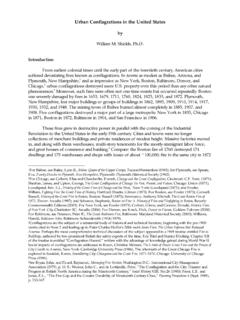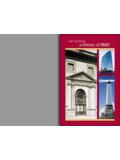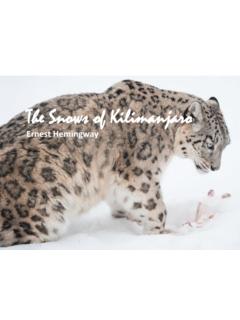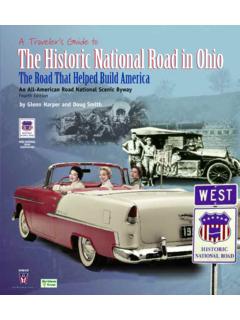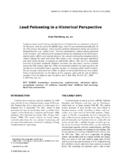Transcription of Philadelphia Bootlegging and The Report of the Special ...
1 Philadelphia Bootlegging and The Reportof theSpecial August Grand JuryDuring the prohibition era of the 1920s , America's largest cities pro-duced famous bootleggers who have become part of our historicalfolklore. In Chicago, Al Capone, Frank Nitti, and Jack Guzik werenotorious in their own day and further immortalized by the televisionseries "The Untouchables." New York City, during the same period,spawned "Dutch" Schultz (Arthur Flegenheimer), Jack "Legs" Dia-mond (originally a Philadelphia boy), Meyer Lansky, "Lucky"Luciano, and Frank Costello. Yet who can name a Philadelphia boot-legger? The lack of famous names from what was then the third largestAmerican city does not reflect a lack of Bootlegging in , it reflects the degree to which widespread corruption and laxlaw enforcement deprived Philadelphia 's bootleggers of the publicitythat might have made them underworld periods during the 1920s , however, found Bootlegging inPhiladelphia the focus of media attention.
2 The first period occurredafter Mayor W. Freeland Kendrick unexpectedly named Smedley , a Brigadier General in the Marines, to be Director ofPublic Safety beginning in January 1924. "Old Gimlet Eye" had wontwo Congressional Medals of Honor for his service in the Spanish-American War, the Philippine pacification, and Latin American ex-peditions. After just two years as Director of Public Safety, though, hetold reporters: "Sherman was right about war, but he was never head ofpolice in Philadelphia ."1 Butler completely reorganized the police department. When he hadtaken over, police precinct boundaries generally corresponded to po-litical ward boundaries, so that local politicians could name the localpolice captain and thereby control the police in the ward.
3 Butler reducedthe forty-two police precincts to twenty-two and transferred largenumbers of officers in an attempt to break the control of politicians overthe police. He also instituted a series of highly publicized raids ofspeakeasies and distilleries. After critics charged that police raids de-prived workingmen of their drinking places but left the wealthy un-1 Fred D. Baldwin, "Smedley D. Butler and Prohibition Enforcement in Philadelphia ,1924-1925," Pennsylvania Magazine of History and Biography, LXXXIV (July 1960), 1 6 NOT ES AND DOCUMENTS Aprildisturbed, Butler attempted to padlock the prestigious Bellevue-Strat-ford Hotel.
4 His policies faced bitter opposition from many politicians,while magistrates sometimes refused to grant search warrants andlooked with little sympathy on the prosecutions that resulted from theraids. When the Marine Corps refused to extend his leave beyond twoyears, Butler resigned from the Corps to continue as Director of PublicSafety. The Mayor promptly fired him; Butler returned to the Ma-rines. His two years in the city captured headlines for Butler but did notbring fame to a few months in 1928-1929, however, an investigative grandjury did briefly focus attention on Philadelphia bootleggers and theirclose ties with city police and local politicians. The grand jury, in turn,was convened because of the publicity resulting from a series ofshootings that accompanied a war among bootleggers in the city.
5 Thekillings began on May 30, 1927, when Joseph Zanghi and VincentCoccozza were shot from a moving car near 8 th and Christian Streets inSouth Philadelphia . The most notable assassination, however, occurredin early August 1928, when Hughie McLoon, the diminutive formermascot of the Philadelphia A's baseball team and a popular figure in thecity's night life, was shot on Chestnut Street. The shooting provokedsufficient outrage that an investigative grand jury spent seven monthssubpoenaing witnesses and bank records, interviewing bootleggers,bankers, and cops, and preparing a final Report of its findings. Excerptsfrom that Report are published first some background. When the Volstead Act imposed nationalprohibition in January 1920, much of the previous structure of im-portation, manufacture, wholesaling, and retailing of alcoholic bever-ages became illegal and largely collapsed.
6 Several results occurred. Oneresult was that Americans drank less. Indeed, the best estimate indicatesthat during prohibition per capita consumption of alcoholic beveragesfell to less than forty percent of the level before World War A secondresult, of course, was that gradually a new set of businessmen estab-lished firms for the importation, manufacture, processing, wholesal-ing, and retailing of alcoholic beverages. At first, the new entrepre-neurs operated on a relatively small scale and a generally ad hoc David E. Kyvig, Repealing National Prohibition (Chicago, 1979), 23-26, also John , "New Perspectives on the Prohibition 'Experiment' of the 192 0's," Journal of SocialHistory II (Fall, 1968), \OIKS \\I) DOCl'MI NKS 217 But as the 1920s progressed, some entrepreneurs gained increased im-portance as coordinators of on-going Bootlegging entrepreneurs who by the late 1920s had emerged as the leadersin various phases of Bootlegging reflected the fact that the new (andillegal) businesses offered economic opportunities for those willing toassume the risks of a criminal career.
7 In American cities generally, thenew entrepreneurs were surprisingly young often in their earlytwenties or even their late teens when prohibition began. They tendedto be uneducated and unskilled, raised in the slums of the city. Theywere typically the children of new immigrants. A national sample ofsuccessful bootleggers from the late 1920s found that approximately 50percent were of Eastern European Jewish background, 25 percent wereItalian, and 25 percent were from other backgrounds mostly Irishand Polish. Philadelphia 's successful bootleggers, while perhaps moreheavily Jewish than the national average, otherwise tended to mirror thenational entrepreneurs, in their own day and in legend, are bestknown for the gang wars during which they shot each other down on thestreets of American cities.
8 Just such widely publicized shootings led tothe convening of the Philadelphia grand jury in August 1928. But thegang wars have obscured recognition of what was the most remarkablecharacteristic of Bootlegging : business cooperation. Those who estab-lished import operations, for instance, not only needed on-going rela-tions with foreign exporters and shippers but with domestic processorsand wholesalers. By the same token, wholesalers within each city pro-vided a nexus between importers and manufacturers, on the one hand,and the thousands of retail outlets, on the other. Only by a complexnetwork of business cooperation could importers, manufacturers, andwholesalers provide the range of alcoholic beverages sold by retailers tothirsty Philadelphians.
9 There is a paradox, then, in understandingsuccessful bootleggers. They tended to be young men with slum back-grounds and minimal business experience; nevertheless, they rapidlyestablished regional and even international cooperation as an inevitablefeature of the Bootlegging Mark H. Haller, "Bootleggers and American Gambling, 1920-1950," in Commission onthe Review of National Policy toward Gambling, Gambling in America, Appendix I (Govern-ment Printing Office, 1976), pages 108-1154 Haller, " Bootlegging in Chicago The Structure of an Illegal Enterprise," Paper readbefore convention of American Historical Association (Dec. 1974), also Haller, "Bootleggers asBusinessmen. From City Slums to City Builders," Paper read to conference on Prohibition 50 Years Later (Eleuthenan Mills, April 1983)2 1 8 NOTES AND DOCUMENTS AprilThe 1928 grand jury uncovered important aspects of the economicand political networks that characterized Bootlegging in important, the grand jury identified Philadelphia 's central role inthe diversion of industrial alcohol.
10 While the Volstead Act restricted themanufacture of alcohol for beverage purposes, alcohol was used in avariety of industrial processes and was a normal component of suchdiverse products as hair oil, lotions, and rubbing alcohol. Federal lawrequired that alcohol manufactured for non-beverage purposes be"denatured" that is, that poisons be added to the alcohol to prevent itsuse in products for human consumption. Because the Delaware Valleywas a major center for the American chemical industry, including themanufacture of industrial alcohol, the area was also a center for di-version by grand jury discovered that "Boo-Boo" Max Hoff, CharleySchwartz, and their partners were the major figures in the diversion ofindustrial alcohol.
